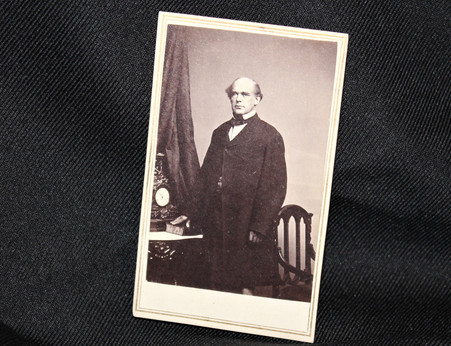 Loading... Please wait...
Loading... Please wait...-
Call us on (973) 810-2976
- My Account
- Gift Certificates
- Items / $0.00
All prices are in All prices are in USD
Categories
- Home
- Sold, Hold, Layaway items
- Rare CDV Image of Salmon P. Chase, Secretary of the Treasury under Lincoln (SOLD)
Rare CDV Image of Salmon P. Chase, Secretary of the Treasury under Lincoln (SOLD)
Out of Stock
Product Description
This is a great original Brady CDV image being offered, it is a standing view of Salmon P. Chase, Secretary of the Treasury under President Lincoln during the Civil War. It is very clear and almost a full-standing view. On the reverse is the backmark “Published by E.&H.T. Anthony, 501 Broadway, New York from Photographic Negative in Brady’s National Portrait Gallery”.
In 1860 Chase attempted to run for president but lost the Republican nomination to Abraham Lincoln. He was elected to the U.S. Senate that same year but resigned in March 1861 after being appointed Secretary of the Treasury in Lincoln’s new administration.
With the start of the Civil War, Chase became responsible for managing the nation’s finances during the massive Union war effort. Among other measures, he took out a $50 million loan from private bankers, instituted new taxes, increased the number of treasury agents and helped push for the establishment of what would become the Internal Revenue Service.
Although he disagreed with the concept on principle, in 1862 Chase helped pass the first Legal Tender Act, which allowed the government to issue paper money as payment for debts. The U.S. government quickly printed $150 million in “greenbacks,” and Chase became famous after he saw to it that his own face appeared on the dollar bill (see pictures). In order to ensure that the banking community accepted the new currency, Chase conceived the National Banking Act, which was voted into law in February 1863. Considered one of Chase’s finest accomplishments, this measure created a national bank and a single currency, enabling the federal government to issue millions of dollars in bonds to help fund the war effort.
While Chase reacted ably to the massive fund’s shortage presented by the Civil War, his relationship with Abraham Lincoln was often strained. Chase believed himself the superior leader and was resentful over having lost the 1860 Republican nomination to Lincoln. During his tenure as Secretary of the Treasury, Chase threatened Lincoln with his resignation three times in order to force the President’s hand on political appointments. When Chase offered his resignation for the fourth time in June 1864, Lincoln chose to accept. His bluff called, Chase reluctantly stepped down as secretary of the Treasury that same month. This image is difficult to find and it is in very nice condition, free shipping.



